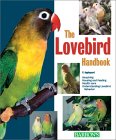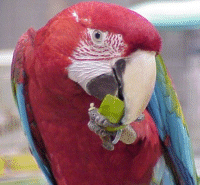A Healthy Diet for Parrots
The best diet for birds has been a subject of debate for many years now. The growing popularity of pet birds has created a market for special foods, from quick-cook pasta mixes to pellets. Many owners feel bombarded with conflicting information. Their veterinarian says feed just pellets, but a friend who breeds hundreds of beautiful parrots says seeds, fresh vegetables, and whole grains are the best diet. So what is the ideal diet for your pet birds?
When asked this question, I always try to consider what these birds would eat naturally in the wild. While this is not always possible to know exactly, it can give some indication as to what would be good ingredients to add to your pet’s diet. This article deals with general guidelines since many species have specific diet requirements (such as lories and lorikeets who need a nectar-based diet). Be sure to research the specific needs of your type of bird.
Seeds: Are seeds really all that bad for you bird? Absolutely not. In the wild birds do eat seeds. The problem in captivity arises when the bird eats only seeds. First, they are high in fat. Birds in captivity do not get the exercise wild birds get when they forage for these foods. Therefore, seeds should make up a reasonable percentage of the diet, generally around 30%, although birds prone to obesity might need a slightly lower percentage. Select top-quality seeds and avoid those packaged in cardboard boxes. You can test the quality of your seed mix by trying to sprout it. Place some seeds in a bit of water in a jar. Set the jar so it leans slightly at an angle. Rinse the seeds after a day, and put the jar at an angle again. If the seeds sprout, they are acceptable. If few or none sprout, these are “dead” seeds and not very nutritious.
Pellets: There are a variety of pelleted diets on the market today, ranging from a very simple brown pellet to brightly colored, fruit-shaped pellets. My personal preference is for the pellets that have the least additives such as color and smell. Pellets should be fresh, so be careful that the container has not been sitting on the pet store shelf for a year. It can take some time for your bird to accept these new foods. Place a small bowl of them in the cage each morning, and replace them even if the bird doesn’t bother to touch them. After a while, they will become accustomed to seeing this new item and will be tempted to try it. This can take anywhere from a few hours for brave birds to a few weeks for more timid, picky birds. I feed pellets and seeds in two separate bowls and allow them to be available most of the day. I have found almost every bird will eventually try them, and now that I have found a brand they like, most look forward to getting a fresh bowl in the morning. My lovebirds and budgies adore Roudybush mini pellets and devour them readily.
Vegetables: Many owners complain that they just can’t get their bird to try vegetables. Every bird will eat these fresh foods. It is in their nature to eat fresh items. The problem is that they get addicted to their seed-only diet and see no reason to experiment with these “new” items. One of the best ways to get birds to try fresh foods is to sprout the seeds they normally eat. Sprouted seeds are much different from dry seeds. They are lower in fat, higher in amino acids and other nutrients. They are a live food and far superior to the “sleeping” seed. There are a number of inexpensive sprouting kits and trays on the market and they are well worth the investment. Basic sprouts can be grown in 3 days. After that, refrigerate the sprouts to preserve them. You should only refrigerate them for 3 days at most before tossing them out, however. If you are worried about the sprouts and bacteria, I suggest soaking the sprouts in a solution of water and grapefruit seed extract (available at most health food stores) for a few minutes, then rinsing them thoroughly.
Another way to get birds to try veggies is to chop up cooked veggies so they are bite sized. Try a mix of peas, corn, and carrots. Place them in a clear bowl (small glass custard bowls are perfect) to give the most visual stimulation. Drop a few unshelled, unsalted sunflower seeds in among the vegetables to tempt your bird. The most important thing is not to give up. Serve this mix every other day for a couple of weeks and in most cases your bird will be tempted to try it. Another favorite is cooked yams or sweet potatoes. The bright color attracts the bird’s eye and the nutrients can’t be beat. Again, be persistent and try different “presentations” to stimulate your bird’s interest. Remove the seed bowl at night before the bird goes to sleep. Serve the vegetables first thing in the morning. Toss in a few things you know your bird will eat, such as a raisin, a few Cheerios, or other tidbits. While foraging for their favorites they will often get a taste of a new vegetable and decide they like it. Don’t put too many favorite tidbits in their, however, or they will simply eat those and neglect the new foods. Remember that slightly cooking your vegetables is often best (carrots especially should be cooked slightly so the birds can assimilate beta carotene). Birds tend to like warm, soft foods, so by cooking them you can often encourage a picky bird to try something new.
Grains: Generally it is easy to get a bird to try brown rice, quinoa, whole grain breads, and other grains. I serve these whenever I’ve made them for the human family. Your goal is not to teach the bird to like carrots, it is to teach the bird to like variety. If it expects new foods each day, it will be less intimidated by these items.
Fruits: Fruits are not nearly as important as vegetables in the diet. A grape, slice of orange, or bit of banana are fine, but not necessary on a daily basis. There are some exceptions for certain types of birds who tend more toward fruit-based diets, so be sure to research the specific needs of the species you own.
This type of varied diet works well on all birds, from finches and canaries to macaws. I have seen many a finch dive into a bowl of steamed brocolli, pasta, and carrots and munch away. Obviously, you can’t give whole, uncooked carrots to a canary, but if prepared appropriately they will eat most of the same foods that hookbills will eat. Make this your resolution for the new millenium: to get your pet birds on the healthiest diet possible so they can live long, robust lives!










